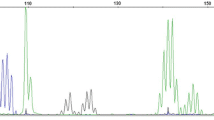Abstract
Background
Muir-Torre syndrome (MTS) is characterized by sebaceous neoplasms with internal malignancies and regarded as a variant of hereditary nonpolyposis colorectal cancer (HNPCC). Pathogenic variations of MTS have been identified in the MSH2, MLH1, and MSH6 genes, with the majority of variations located in MSH2.
Objectives
To present an MTS patient who was the only individual with skin malignancies within a cancer-prone pedigree and to showthe usefulness ofRNA-based genetic analysis in the investigation of MTS.
Materials & methods
A 77-year-old man who had operated X-ray equipment at his workplace in his twenties was clinically diagnosed with MTS and investigated by RNA-based analysis, multiplex ligation-dependent probe amplification, and genomic DNA sequencing.
Results
The patient had suffered from sebaceous tumours, squamous cell carcinomas of the skin, and colon cancer. The patient’s family history was remarkable for visceral malignant diseases. Genetic analysis revealed homologous recombination between two Alu elements within intron 4 and 5 of the MLH1 gene. The rearrangement caused a 1,222-bp deletion, including the entire exon 5. Deletion of exon 5 has previously been reported only in two patients with HNPCC, and not in patients with MTS.
Conclusions
For the genetic analysis of MTS, the possibility of rare copy number variations of MLH1, as well as MSH2 variations, should be considered. RNA-based screening using puromycin is recommended in order to identify such variations. It remains unclear why only the proband among the pedigree had skin malignancies, however, the skin carcinogenesis might have been related to occupational radiation exposure.
Similar content being viewed by others
References
Schwartz RA, Torre DP. The Muir-Torre syndrome: a 25-year retrospect. J Am Acad Dermatol 1995; 33: 90–104.
Mangold E, Rahner N, Friedrichs N, et al. MSH6 mutation in Muir-Torre syndrome: could this be a rare finding? Br J Dermatol 2007; 156: 158–62.
Peltomäki P. Role of DNA mismatch repair defects in the pathogenesis of human cancer. J Clin Oncol 2003; 21: 1174–9.
Mathiak M, Rütten A, Mangold E, et al. Loss of DNA mismatch repair proteins in skin tumors from patients with Muir-Torre syndrome and MSH2 or MLH1 germline mutations: establishment of immunohistochemical analysis as a screening test. Am J Surg Pathol 2002; 26: 338–43.
South CD, Hampel H, Comeras I, Westman JA, Frankel WL, de la Chapelle A. The frequency of Muir-Torre syndrome among Lynch syndrome families. J Natl Cancer Inst 2008; 100: 277–81.
Nomura S, Sugano K, Kashiwabara H, et al. Enhanced detection of deleterious and other germline mutations of hMSH2 and hMLH1 in Japanese hereditary nonpolyposis colorectal cancer kindreds. Biochem Biophys Res Commun 2000; 271: 120–9.
Sumitsuji I, Sugano K, Matsui T, et al. Frequent genomic disorganisation of MLH1 in hereditary non-polyposis colorectal cancer (HNPCC) screened by RT-PCR on puromycin treated samples. J Med Genet 2003; 40: e30.
Tang R, Hsiung C, Wang JY, et al. Germ line MLH1 and MSH2 mutations in Taiwanese Lynch syndrome families: characterization of a founder genomic mutation in the MLH1 gene. Clin Genet 2009; 75: 334–45.
Bapat B, Xia L, Madlensky L, et al. The genetic basis of Muir-Torre syndrome includes the hMLH1 locus. Am J Hum Genet 1996; 59: 736–9.
Tanyi M, Olasz J, Lukács G, et al. A new mutation in Muir-Torre syndrome associated with familiar transmission of different gastrointestinal adenocarcinomas. Eur J Surg Oncol 2009; 35: 1128–30.
Ponti G, Pellacani G, Ruini C, et al. Muir-Torre syndrome or phenocopy? The value of the immunohistochemical expression of mismatch repair proteins in sebaceous tumors of immunocompromised patients. Fam Cancer 2014; 13: 553–61.
Svec J, Schwarzová L, Janosíková B, et al. Synchronous gastric and sebaceous cancers, a rare manifestation of MLH1-related Muir-Torre syndrome. Int J Clin Exp Pathol 2014; 7: 5196–202.
Ponti G, Meschieri A, Pollio A, et al. Fordyce granules and hyperplastic mucosal sebaceous glands as distinctive stigmata in Muir-Torre syndrome patients: characterization with reflectance confocal microscopy. J Oral Pathol Med 2015; 44: 552–7.
Wijnen J, van der Klift H, Vasen H, et al. MSH2 genomic deletions are a frequent cause of HNPCC. Nat Genet 1998; 20: 326–8.
Wagner A, Barrows A, Wijnen JT, et al. Molecular analysis of hereditary nonpolyposis colorectal cancer in the United States: high mutation detection rate among clinically selected families and characterization of an American founder genomic deletion of the MSH2 gene. Am J Hum Genet 2003; 72: 1088–100.
Becker-Schiebe M, Hannig H, Hoffmann W, Donhuijsen K. Muir-Torre syndrome -an uncommon localization of sebaceous carcinomas following irradiation. Acta Oncol 2012; 51: 265–8.
Yozu M, Symmans P, Dray M, et al. Muir-Torre syndromeassociated pleomorphic liposarcoma arising in a previous radiation field. Virchows Arch 2013; 462: 355–60.
Tokairin Y, Kakinuma S, Arai M, et al. Accelerated growth of intestinal tumours after radiation exposure in Mlh1-knockout mice: evaluation of the late effect of radiation on a mouse model of HNPCC. Int J Exp Pathol 2006; 87: 89–99.
Author information
Authors and Affiliations
Corresponding author
Additional information
To cite this article: Shiki M, Hida T, Sugano K, Kaneko R, Kamiya T, Sakurai A, Yamashita T. Muir-Torre syndrome caused by exonic deletion of MLH1 due to homologous recombination. Eur J Dermatol 2017; 27(1): 54-8 doi:10.1684/ejd.2016.2916
About this article
Cite this article
Shiki, M., Hida, T., Sugano, K. et al. Muir-Torre syndrome caused by exonic deletion of MLH1 due to homologous recombination. Eur J Dermatol 27, 54–58 (2017). https://doi.org/10.1684/ejd.2016.2916
Accepted:
Published:
Issue Date:
DOI: https://doi.org/10.1684/ejd.2016.2916




